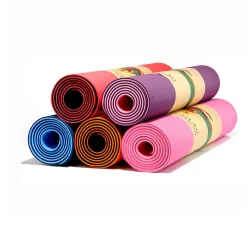Choosing the Perfect Yoga Mat: What to Look For
2024-09-21
A yoga mat is more than just a piece of equipment — it’s the foundation of your practice. Whether you’re a seasoned yogi or a beginner, finding the right yoga mat can significantly impact your experience on the mat. In this guide, we’ll explore the key factors to consider when choosing the perfect yoga mat.
1. Thickness
One of the first things to look at is the thickness of the mat. Yoga mats typically range from 1/16 inch (1.5 mm) to 1/4 inch (6 mm) in thickness.
- Thin mats (1.5 mm - 3 mm): These are great for more dynamic styles of yoga, like Vinyasa or Ashtanga, where stability is crucial. A thin mat provides a stronger connection to the ground, which can enhance your balance during poses.
- Thicker mats (4 mm - 6 mm): If you need more cushioning, especially for seated or kneeling poses, a thicker mat is ideal. These mats are also great for those who practice Yin or restorative yoga, as they provide additional comfort.
Consider your style of practice and whether you need more or less cushioning for your joints.
2. Material
The material of your yoga mat determines its durability, grip, and environmental impact. Some popular materials include:
- PVC (Polyvinyl Chloride): PVC mats are highly durable and offer excellent grip, especially for those who sweat a lot during practice. However, PVC is not eco-friendly and may release toxins, so it’s best for those seeking a budget-friendly, durable option.
- TPE (Thermoplastic Elastomer): TPE mats are more environmentally friendly than PVC and still offer good grip and durability. They’re lightweight, making them ideal for those who carry their mats to and from the studio.
- Natural Rubber: For eco-conscious yogis, natural rubber mats are a popular choice. They provide excellent grip and cushioning but may be heavier and pricier. Natural rubber is also biodegradable, making it a sustainable option.
- Cork and Jute: These natural materials are gaining popularity for their sustainable and non-slip properties. Cork mats offer great traction, even when wet, and are resistant to odor, while jute is lightweight and provides a textured surface for added grip.
3. Texture and Grip
The texture of a yoga mat affects its traction and grip, which is essential for maintaining stability in poses. Some mats have a smooth surface, while others feature raised patterns for extra grip.
- Smooth Mats: These are generally softer and more comfortable for lying down or seated poses. However, they can become slippery when wet, which may not be ideal for hot yoga.
- Textured Mats: Mats with raised surfaces provide a better grip, even during sweaty sessions. They are perfect for styles like Bikram or hot yoga, where a slip-resistant surface is critical.
4. Size and Weight
Standard yoga mats are usually 68 inches long and 24 inches wide, but taller yogis may want a longer mat (up to 72 or 84 inches). The weight of the mat is also important if you plan to carry it frequently. Heavier mats provide more cushioning but are less portable, while lighter mats are easier to transport but may sacrifice some comfort.
5. Price and Durability
Yoga mats come in a wide price range, from budget options to premium mats. While it’s tempting to go for a cheaper mat, investing in a high-quality one will save you money in the long run. A durable, high-quality mat will last through years of practice, whereas cheaper mats may wear out or lose grip quickly.
Conclusion
Choosing the perfect yoga mat requires considering factors like thickness, material, grip, and size to match your style of practice. Whether you prioritize comfort, sustainability, or portability, the right yoga mat will enhance your experience, making every practice more enjoyable. Take your time to find a mat that resonates with your needs, and watch your yoga journey unfold on the perfect foundation.



